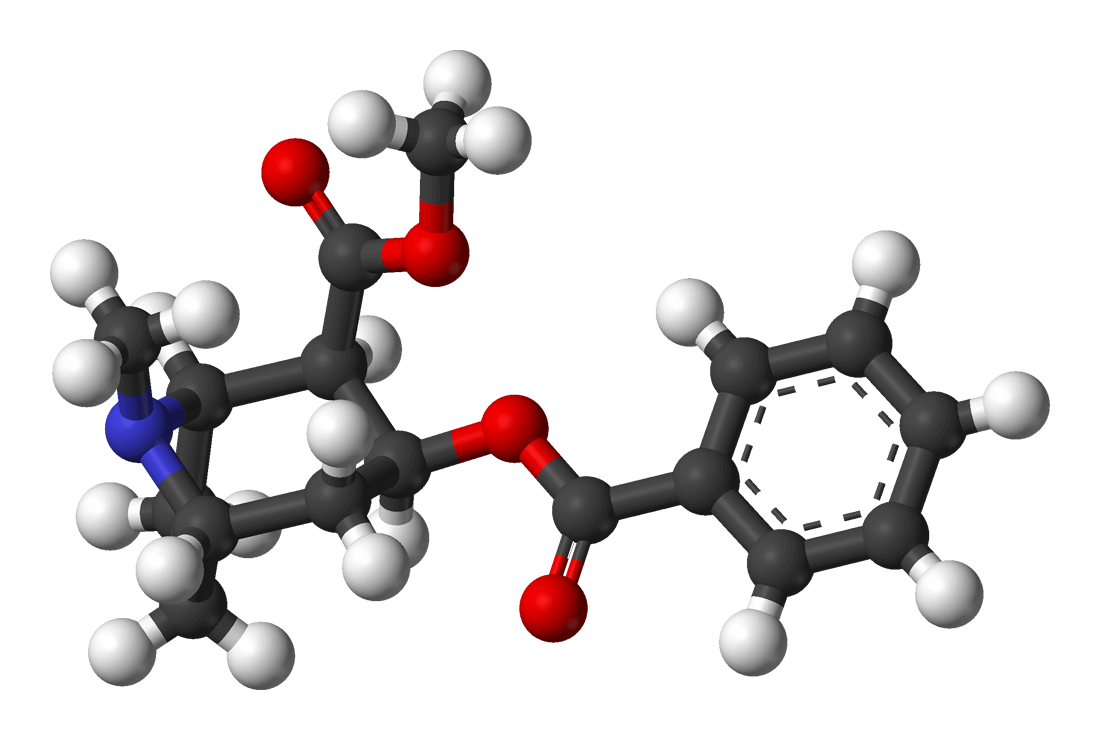Cocaine: Types and Effects

Cocaine is a powerful stimulant. It is extremely addictive and used almost exclusively as a recreational drug. It comes from the coca leaf and became popular as a drug in the 1980’s. In its natural form, the coca leaf, it has been consumed for thousands of years by the native peoples of South America.
Its pure chemical form is cocaine hydrochloride, a substance that has been made in labs for over 100 years. At the beginning of the 20th century, it was the main ingredient of many elixirs and tonics used for medicinal purposes. Even today it is still used as an anesthetic for throat, ear, and eye surgeries.
“Coca is the exhaustive response to the most pressing need of the current era: lack of limits.”
-Roberto Saviano-
Cocaine was also a component of several soft drinks. The best known of these is Coca Cola. The original formula contained up to 8 milligrams of cocaine per liter.
However, the drug became unpopular due to its serious side effects and Coke withdrew it as an ingredient in 1903. In 1914, it became an illegal drug.
It is now difficult to find cocaine in its chemically pure form. Instead, it’s often mixed with starches, talcs, sugar, or other elements. On the street, it’s often referred to as “blow”, “flake”, “coke”, or “snow.”
Cocaine hydrochloride
As we said, the pure chemical form of cocaine is cocaine hydro-chloride. Although the levels of purity vary depending on manipulation, the highest quality cocaine reaches 98% purity. In the black market, dealers call it “Yen.” It’s the most expensive and looks whiter and brighter than others.

The hydrochloride comes in the form of powder. It’s estimated that the powdered cocaine sold on the streets is between 5 and 40% pure. Sometimes it’s mixed with very dangerous substances such as amphetamines or certain anesthetics.
Cocaine powder is usually aspirated or “snorted.” However, many users inject it.
There are different varieties of “white cocaine” of medium or low purity. The most popular is called “chalk.” This is because it has a grayish-white color and is somewhat dull. This variety is highly euphoric.
Then there is another category called “yellowish cocaine.” Its most noticeable characteristic is a strong smell of gasoline or kerosene. It is the most powerful of all.
Other types of cocaine
Cocaine is also found in “base” form. This is what is popularly known as “crack.” The consumption of crack went up when authorities began to impose severe restrictions on the chemicals necessary to make cocaine hydrochloride.
This action made the price of cocaine go up and reach a level that many users couldn’t afford. In response, the base form became commercialized because it’s 15 times cheaper.
Crack is a mix of cocaine hydrochloride and other chemicals such as ammonia, ether, and sodium bicarbonate. It’s normally smoked in a pipe and has much stronger effects compared to refined cocaine.
Furthermore, it is potentially more addictive and increases the risk of death. It is called crack because of the sound it makes when it’s crushed.
Another product made from this drug is cocaine paste, also called “cocaine sulfate”. In this product, up to 50% of the drug is made up of a sulfate.
During its production, toxic chemicals such as methanol and sulfuric acid are used. Usually, users mix it with marijuana or tobacco and smoke it.
Both crack and cocaine sulfate produce an effect categorized as a “flash.” That is to say, it has a quick, very potent effect. That’s why addicts find it necessary to consume multiple doses in succession, to prolong the effect. Both have a high risk of overdose.
Short-term effects of cocaine
The effects of cocaine appear almost immediately after consumption. Sometimes these effects last only a few minutes, other times they may last an hour. The substance provokes feelings of euphoria and vitality. The user feels mentally alert and feels it in his or her sensory perceptions, especially vision, hearing, and touch.
Using cocaine habitually diminishes the need to eat and sleep. Some people use cocaine so they can finish work faster. On the other hand, some people feel that it slows them down.

The duration and intensity of the effect depends on the type of cocaine and how it was consumed. The faster the absorption into the body, the more intense but short-lived the effect. Sometimes users will experience unrest, anguish, or irritability. Spasms, paranoia, and vertigo are also common.
From a physiological perspective, cocaine disrupts the rhythm of the heart and can cause headaches, stomachaches, and vomiting.
In the case of an overdose, the user may experience convulsions, strokes, or fall into a coma. Immediate death is rare, but it can lead to cardiac arrest. This has the potential to lead to death.
Long-term effects
The main long-term effect of cocaine use is severe addiction. Since the potential for addiction is so high, it’s impossible for a person to predict to what extent they will need the drug after the first time he or she uses it.
There is also a high risk for relapse once a user stops using it. This can even occur after years of sobriety.
The brain adapts to the consumption of cocaine. This means that the person feels less and less satisfied over time. For this reason, the addict must constantly increase the dose in order to achieve the same euphoric sensation.
Over time, the pleasant sensations caused by the drug will be replaced with anguish, paranoia, and explosive anger.
In the most serious cases, prolonged drug use can cause the user to lose touch with reality for long periods of time. Hallucinations start, first auditory, and then paranoid psychosis occurs.
Cocaine fractures and destroys the personality. It causes the user’s life to revolve around it.
MRI’s show that the brain of someone addicted to cocaine has fewer dopamine receptors. As a consequence, the person can no longer feel gratifying sensations in a normal way.
The future of an addict
It is very difficult to predict the fate of a person addicted to cocaine. This is because it depends on many factors and some of it is up to chance.
As long as consumption is maintained, the risk of death progressively increases. As does damage to personality and relationships with others.
Addiction to this type of substance usually leads to crime or illegal actions to obtain the drug.
At present, different medications are being tested, but none of them have passed all the tests.

Support groups are always an excellent choice. Usually, they are accompanied by individual therapy. This, plus adequate diet, a consistent exercise plan, and a support network seems to have good results in most cases.
Now, getting out of addiction is not easy. Therefore, the best thing is always prevention. Cocaine is not a drug to try out of curiosity or for a new experience.
One single use has the potential to unleash something that, in the long run, could end up a serious tragedy.
Cocaine is a powerful stimulant. It is extremely addictive and used almost exclusively as a recreational drug. It comes from the coca leaf and became popular as a drug in the 1980’s. In its natural form, the coca leaf, it has been consumed for thousands of years by the native peoples of South America.
Its pure chemical form is cocaine hydrochloride, a substance that has been made in labs for over 100 years. At the beginning of the 20th century, it was the main ingredient of many elixirs and tonics used for medicinal purposes. Even today it is still used as an anesthetic for throat, ear, and eye surgeries.
“Coca is the exhaustive response to the most pressing need of the current era: lack of limits.”
-Roberto Saviano-
Cocaine was also a component of several soft drinks. The best known of these is Coca Cola. The original formula contained up to 8 milligrams of cocaine per liter.
However, the drug became unpopular due to its serious side effects and Coke withdrew it as an ingredient in 1903. In 1914, it became an illegal drug.
It is now difficult to find cocaine in its chemically pure form. Instead, it’s often mixed with starches, talcs, sugar, or other elements. On the street, it’s often referred to as “blow”, “flake”, “coke”, or “snow.”
Cocaine hydrochloride
As we said, the pure chemical form of cocaine is cocaine hydro-chloride. Although the levels of purity vary depending on manipulation, the highest quality cocaine reaches 98% purity. In the black market, dealers call it “Yen.” It’s the most expensive and looks whiter and brighter than others.

The hydrochloride comes in the form of powder. It’s estimated that the powdered cocaine sold on the streets is between 5 and 40% pure. Sometimes it’s mixed with very dangerous substances such as amphetamines or certain anesthetics.
Cocaine powder is usually aspirated or “snorted.” However, many users inject it.
There are different varieties of “white cocaine” of medium or low purity. The most popular is called “chalk.” This is because it has a grayish-white color and is somewhat dull. This variety is highly euphoric.
Then there is another category called “yellowish cocaine.” Its most noticeable characteristic is a strong smell of gasoline or kerosene. It is the most powerful of all.
Other types of cocaine
Cocaine is also found in “base” form. This is what is popularly known as “crack.” The consumption of crack went up when authorities began to impose severe restrictions on the chemicals necessary to make cocaine hydrochloride.
This action made the price of cocaine go up and reach a level that many users couldn’t afford. In response, the base form became commercialized because it’s 15 times cheaper.
Crack is a mix of cocaine hydrochloride and other chemicals such as ammonia, ether, and sodium bicarbonate. It’s normally smoked in a pipe and has much stronger effects compared to refined cocaine.
Furthermore, it is potentially more addictive and increases the risk of death. It is called crack because of the sound it makes when it’s crushed.
Another product made from this drug is cocaine paste, also called “cocaine sulfate”. In this product, up to 50% of the drug is made up of a sulfate.
During its production, toxic chemicals such as methanol and sulfuric acid are used. Usually, users mix it with marijuana or tobacco and smoke it.
Both crack and cocaine sulfate produce an effect categorized as a “flash.” That is to say, it has a quick, very potent effect. That’s why addicts find it necessary to consume multiple doses in succession, to prolong the effect. Both have a high risk of overdose.
Short-term effects of cocaine
The effects of cocaine appear almost immediately after consumption. Sometimes these effects last only a few minutes, other times they may last an hour. The substance provokes feelings of euphoria and vitality. The user feels mentally alert and feels it in his or her sensory perceptions, especially vision, hearing, and touch.
Using cocaine habitually diminishes the need to eat and sleep. Some people use cocaine so they can finish work faster. On the other hand, some people feel that it slows them down.

The duration and intensity of the effect depends on the type of cocaine and how it was consumed. The faster the absorption into the body, the more intense but short-lived the effect. Sometimes users will experience unrest, anguish, or irritability. Spasms, paranoia, and vertigo are also common.
From a physiological perspective, cocaine disrupts the rhythm of the heart and can cause headaches, stomachaches, and vomiting.
In the case of an overdose, the user may experience convulsions, strokes, or fall into a coma. Immediate death is rare, but it can lead to cardiac arrest. This has the potential to lead to death.
Long-term effects
The main long-term effect of cocaine use is severe addiction. Since the potential for addiction is so high, it’s impossible for a person to predict to what extent they will need the drug after the first time he or she uses it.
There is also a high risk for relapse once a user stops using it. This can even occur after years of sobriety.
The brain adapts to the consumption of cocaine. This means that the person feels less and less satisfied over time. For this reason, the addict must constantly increase the dose in order to achieve the same euphoric sensation.
Over time, the pleasant sensations caused by the drug will be replaced with anguish, paranoia, and explosive anger.
In the most serious cases, prolonged drug use can cause the user to lose touch with reality for long periods of time. Hallucinations start, first auditory, and then paranoid psychosis occurs.
Cocaine fractures and destroys the personality. It causes the user’s life to revolve around it.
MRI’s show that the brain of someone addicted to cocaine has fewer dopamine receptors. As a consequence, the person can no longer feel gratifying sensations in a normal way.
The future of an addict
It is very difficult to predict the fate of a person addicted to cocaine. This is because it depends on many factors and some of it is up to chance.
As long as consumption is maintained, the risk of death progressively increases. As does damage to personality and relationships with others.
Addiction to this type of substance usually leads to crime or illegal actions to obtain the drug.
At present, different medications are being tested, but none of them have passed all the tests.

Support groups are always an excellent choice. Usually, they are accompanied by individual therapy. This, plus adequate diet, a consistent exercise plan, and a support network seems to have good results in most cases.
Now, getting out of addiction is not easy. Therefore, the best thing is always prevention. Cocaine is not a drug to try out of curiosity or for a new experience.
One single use has the potential to unleash something that, in the long run, could end up a serious tragedy.
This text is provided for informational purposes only and does not replace consultation with a professional. If in doubt, consult your specialist.







